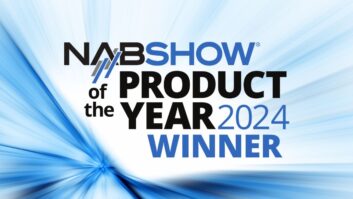Status Check
Feb 1, 1999 12:00 PM,
Mark Waldrep
DVD-Video hardware and software arrived in a big way last Christmas. Thenew format dominated the consumer electronics retail market, selling morethan 100,000 hardware units per week during the final days of 1998.Inexpensive second and third generation DVD-Video players were in shortsupply at many retailers. Even larger numbers of DVD-ROM equipped PCs werepurchased during the same period, a trend that will increase during thenext 12 months-some estimates have the number of DVD-ROM equipped PCspassing 35 million by the end of the year. As the most rapidly accepted newentertainment format in the history of consumer electronics, DVD has becomepart of our lexicon even though most media experts incorrectly refer to itas Digital Video Disc (it does not actually stand for anything, not evenDigital Versatile Disc). DVD-Video software is widely available forpurchase or rent at your local video outlet or with next day deliverythrough an online virtual outlet. DVD is here to stay, and a completeunderstanding of how it works will allow you to serve as a technologyexpert on behalf of your customers.
Manufacturers of DVD-Video players have extended their product lines toinclude multi-disc changers and portable personal units, and automobilecompanies have begun to offer their sport utility vehicles withrear-passenger DVD-Video players and screens. There are industrialDVD-Video players available that extend the capabilities of the homeplayers for commercial purposes. The new players can operate under thecontrol of a computer through built-in serial interfaces, use light pens toread bar codes, instantly access video clips, operate under scheduledautomation and take input from a mouse.
A new category of machines that integrate the functionality of manyindividual units into a single convergent set-top box is currently beingdesigned. Imagine being able to access your cable service, view DVD movies,play complex networked real-time 3-D games, send and receive e-mail, browsethe Web, have a video conference and complete an online banking transactionusing a single box hooked up to your television and a telephone line-all ofthis without a computer.
The good news, with regard to the consumer electronics world, has alreadybegun to translate into innovative uses of the technology beyond the homeentertainment systems in consumer living rooms. The viability of theDVD-Video format to service the needs of media integrators and contractors,education and training developers and marketing and communicationsprofessionals has already been recognized. Although not yet implemented,this format allows for many future programming possibilities in residentaland commercial command control markets. Further development holds greatpossibilities with interactive DVD software once developers begin to designfor systems contracting and installation. The future of systems control maybe as simple as navigating through DVD software custom designed forspecific control applications. The corporate division of our company, AIXMedia Group, has completed a series of high-profile interactive sales andmarketing DVD-Video discs for Macrovision, Philips, Sonic Solutions andMotorola. We recently completed an interactive disc for Motorola used atthe Consumer Electronics Show in Las Vegas. A looped section of the discwas used in the reception area to attract passers-by while other sectionsdemonstrated and compared the advantages of various types of digital audio(including the first head-to-head comparison of LPCM, Dolby Digital andDTS). A third area of the same disc emulated the functionality of its newintegrated set-top box known as the Streamaster (one of the first examplesof the convergent media box mentioned above). Other companies andorganizations will soon realize that DVD-Video can deliver moreinteractivity and production value than has been used on most of thereleases from Hollywood, and the resultant discs can be easily played andnavigated using inexpensive machines hooked up to standard TV monitors.
To realize the potential of this emerging disc format and to decide whetherthe time is right to acquire and learn the tools and techniques to producethese discs, we need to examine and understand the key components of aDVD-Video disc that make it so compelling for non-entertainmentapplications. The most important among these include its navigationalcapabilities and norms and the hybrid extensions available through WebDVDand DVD-ROM. The power of these new 12 cm discs lies in thinking beyond theinformation found on glossy brochures and specification sheets. Although itis true that the DVD-Video format was conceived and developed withHollywood in mind, there is plenty of capability in the specification toengage imaginative developers. The fact that DVD-Video is a locked anduniversally accepted standard is what makes it so viable in comparison tothe ever-changing world of multimedia computers. The consortium of Japaneseand American companies that hammered out the specification did an excellentjob. It is up to the members of the development community to implementapplications within that specification consistently and robustly.
NavigationMaybe you are one of the hundreds of thousands of people that purchased acomplete DVD-Video home entertainment system for Christmas and have begunto explore the software offering found at your local video shop. You havegotten pretty good at inserting the disc into the player and sitting backto enjoy the feature. The remote control of your DVD-Video player seemssimilar to the other commanders that you have stacked on your coffee tablebut has a few extra buttons. As a seasoned multimedia expert, you havebegun to evaluate the features on the software titles beyond the playing ofthe motion picture and have noticed that different discs present differentnavigational experiences. The prohibited symbol keeps popping up on yourscreen whenever you hit the “title” button or maybe nothing happens at all.Some discs present an elegant flow of motion graphic menus, and others gostraight to the feature and offer limited access to informational stills.Other discs blatantly state right on the packaging that they contain nomenus at all, just a linear video transfer of the movie. All of the discsmust adhere to the video specification, but the details of their individualimplementation have resulted in confusion for the consumer.
One head of DVD production for a prominent Hollywood studio was not awareof the “title” button on the remote controller and had no idea what it did.This was a studio that had produced and released over 250 titles, and not asingle one used the button. I was assured that this was a question thatwould be asked of the authoring and compression house responsible for thetitles. The information I got back was that the authoring folks decided itwas best not to inform their client of the navigational details associatedwith the button because it might unduly confuse them.
Even Apple Computer, a company currently doing a lot to promote itself as adifferent-thinking enterprise, has some confusion relating to thefunctioning of a DVD-Video title from the navigational point of view. A fewmonths back, I installed my DVD-ROM drive, MPEG-2 decoder card andDVD-Video player software in my new G3 PowerBook and was quite surprised tolearn that all of the titles that I had developed (more than 200) would notfunction in the player. The discs would start up just fine but hang at thevideo main menu. It seems that Apple’s testing department (and thespecification for the player software) used only products from WarnerBrothers to evaluate its DVD player software. Because Warner has never usedthe “title” button on any of its discs, Apple’s “title” button is tuckedaway in the glove compartment of its software represented by a ratherobscure icon. As a friend and supporter of Apple and in the interest ofcompatibility, I contacted Apple about the problem and even sent a slightlyrevised version of the navigator graphic replacing the “eject” button (acompletely superfluous function) with the “title” button. The subsequentversion of the software (v. 1.1) fixed the playability of a title withmotion graphic menus in the title section but ignored the visibility of the”title” button. The reason stated was because the graphic designer of itsDVD player did not like the aesthetics of the redesign.
Pioneer, a substantial contributor to the format, continues to choose itsown method of implementing the “title” button functionality. I visited aclient recently who had purchased a new Pioneer DVD-Video player. As theowner of several of their machines, including the industrial model, I wasused to pressing the “title” button followed by the “menu” button to makethe title menu appear. My clients, however, were not familiar with thisaspect of the new player and had become quite frustrated at their newmachine. It is puzzling that manufacturers and authoring/compression housescannot seem to come up with a series of guidelines that will assure aconsistent navigational experience.
Part of the reason that so much confusion exists is that for the most part,the authoring and compression houses have no experience in interactivedesign. Most are extensions to video post production houses, facilitiesthat specialize in linear thinking and product delivery. The initialdemands of Hollywood for DVD-Video titles did not require them to do anyinteractivity (check out the early, static releases), and so they did not.According to industry leaders, “A” movie titles were enough to driveconsumers to the new format. These days, the situation has changed.DVD-Video titles are becoming more and more interactive as competitionincreases.
Here are a few suggestions toward standardizing the basic navigationalexperience. For the manufacturers and the software developers responsiblefor the virtual DVD players found on computers with DVD-ROM, make sure thatthe “title” and “menu” buttons are prominent. They should function with asingle button press, and the software version should have keyboardequivalents for instant access. The actual DVD-Video titles shoulduniformly implement the “title” function as “return me to the top mostdecision point on this disc”. Do not disable the use of the “title” button,and do not take me back to the FBI warning. When a user presses the “title”button, he is trying to get back to the starting point of the disc. This isusually the main menu and may, in fact, be the same point to which the”menu” button brings you for a simple title. As for the “menu” button, itnavigates to the locally specified VTS (Video Title Set). If a disc has asingle VTS, then that should be the main menu. This is how most discs areimplemented. For a more complicated project, however, the author can usemultiple video title sets and allow users to access the last major decisionmenu rather then sending them back to the main menu. For example, mostmovies have some sort of scene or chapter selection menu to accessindividual sections of a longer feature. The jumping-off point is often aseries of miniature video windows playing a brief segment of the movie atthe destination point. If the user selects a scene, starts to view themovie and then abruptly changes his mind, there should be a way to returnto the scene/chapter selection screen instantly. Hitting the title buttonon most DVD-Video titles takes the user instead to the main menu, requiringan annoying series of navigation moves back to the scene selection screen.This is where the author should have placed a separate VTS (see Figure 1).
WebDVD and DVD-ROMAs mentioned above, the installed base of set-top DVD-Video players versusthe number of PCs equipped with DVD-ROM drives is about 1:10. The reason issimple: People purchase the latest computer gear far more often than theyredo their home entertainment system. This means that a substantial numberof people are going to be playing DVD-Video titles using a software playeron their computers. In fact, many of the computers are equipped withcomposite video or S-VHS jacks for a direct connection to a TV monitor. Fordevelopers of DVD-Video titles, the potential consumer base is far largerthan just the set-top box users. With the popularity of the Internet andthe power of the new DVD-ROM computers, it makes sense to include softwareon a hybrid sector of the DVD-Video title that takes advantage of thecomputer’s capabilities when used in a DVD-ROM with a PC. Thesecapabilities include the ability to access the Internet and execute suchprograms designed specifically for computers as games and screen savers.
The Internet connection from a DVD-Video/DVD-ROM hybrid is the latest trendin title releases. The first title to do so, Sgt. Kabukiman N.Y.P.D. fromthe famed Troma Studios in New York allowed viewers to connect directly tothe Troma Web site. Such recent titles as Lost in Space from New Line HomeVideo and Wrongfully Accused from Morgan Creek have implemented morecomplex Internet features. Wrongfully Accused, a particularly innovativeexample, takes viewers of the disc directly to the movie’s Web site andthen offers several bonus video clips if the user can correctly answer 10trivia questions about the film. SpinWare Connect, a new disc/Internetprotocol, allows video files located on the disc to be played under controlof the Web site. The bandwidth limitations of a modem for high-qualityaudio and video playback are overcome by this hybrid methodology. Thepossibilities for the distribution of time sensitive or commerciallyvaluable materials are profound. A single DVD disc could carry many hoursof audio and video allowing access only when connected to a validating Website. The Morgan Creek title unlocks the bonus footage through the Web butplays the video stream from an encrypted file located on the DVD disc. (SeeFigure 2.)
The possibilities of a Web-connected DVD hybrid disc are tantalizing. Asales and marketing staff could carry presentations that are updated over aWeb connection daily but access a standard array of graphics, audio andvideo from DVD. A training disc could allow graduated access to additionalchapters only after successful completion of an online examination. Thecombination of the Web and high-quality audio and video overcomes manytechnical frustrations-no more waiting for a simple video to download.Kiosk developers could remotely update and control the content locatedinside a particular machine without requiring a T-1 line to transferhigh-bandwidth audio and video data if there was a DVD disc inside.
1999 will firmly establish the DVD format as the disc format for theentertainment industry and will open the door to uses beyond the consumerbase. DVD-Video is an incredibly robust, consumer-friendly, inexpensive wayto deliver uncompromised audio and video to a mass market. As developersand technology integrators, it is important to understand its structure andflexibility and to uniformly design and implement compelling applicationsthat contribute to its long-term success in a wide variety of uses.










